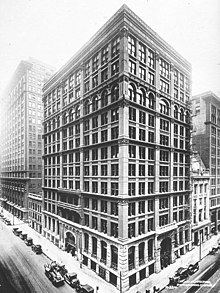Home Insurance Building
| Home Insurance Building | |
|---|---|

The Home Insurance Building
|
|
| General information | |
| Type | Office |
| Location | Chicago, United States |
| Coordinates | 41°52′47″N 87°37′55″W / 41.8796°N 87.6320°WCoordinates: 41°52′47″N 87°37′55″W / 41.8796°N 87.6320°W |
| Completed | 1884 |
| Demolished | 1931 |
| Height | |
| Roof | Originally 138 ft (42 m) |
| Top floor | After addition of the final two floors – 180 feet (54.9 meters) |
| Technical details | |
| Floor count | 10 (later 12) |
| Design and construction | |
| Architect | William Le Baron Jenney |
| References | |
The Home Insurance Building was a skyscraper in Chicago, generally noted as the first tall building to be supported, both inside and outside, by a fireproof metal frame.
The building opened in 1884, and was demolished 47 years later in 1931.
It was constructed in 1884 in Chicago, Illinois, and was the first tall building to use structural steel in its frame, but the majority of its structure was composed of cast and wrought iron. While the Ditherington Flax Mill was an earlier fireproof-metal-framed building, it was only five stories tall.
Due to the Chicago building's unique architecture and weight-bearing frame, it is considered the world's first skyscraper. It had 10 stories and rose to a height of 138 ft (42 m) In 1890, two additional floors were added.
The architect was William Le Baron Jenney. The building weighed only one-third as much as a stone building would have; city officials were so concerned, they halted construction while they investigated its safety. The Home Insurance Building is an example of the Chicago School of Architecture. The building set precedent in skyscraper construction. Minneapolis architect Leroy Buffington patented the concept of the skeletal-frame tall building in 1888, and proposed "a 28-story 'stratosphere-scraper'—a notion mocked by the architectural press of the time as impractical and ludicrous." His proposal nonetheless attracted the attention of the national architectural and building communities to the possibilities of iron skeletal framing, "which in primitive form had been around for decades."
A forensic analysis done during its demolition purported to show the building was the first to carry both floors and external walls entirely on its metal frame, but details and later scholarship have arguably disproved this, and it has been asserted the structure must have relied upon both metal and masonry elements to support its weight, and to hold it up against wind. Although the Home Insurance Building made full use of steel framing technology, in this theory it was not a pure steel-framed structure since it rested partly on granite piers at the base and on a rear brick wall. The exterior was created from brick.
...
Wikipedia
